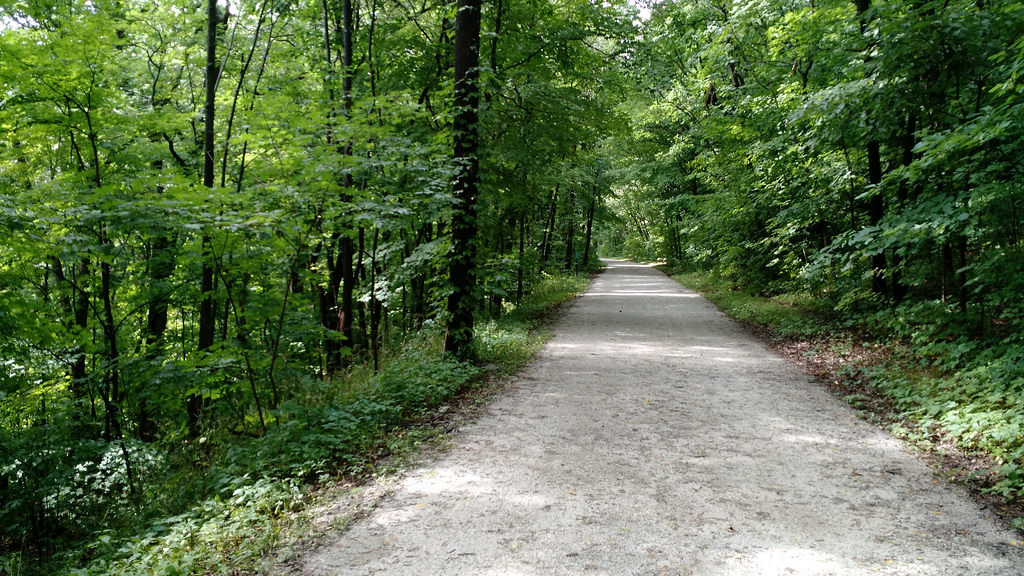
The Kal-Haven trail between Kalamazoo and South Haven does not allow motorized vehicles. Image: Philip Brewer, Flickr
By Maxwell Evans
Capital News Service
For Michigan bicyclists, a 2016 crash that killed five and left four injured is still a potent reminder of the importance of protecting non-motorized vehicles that take the road.
“That was an event that has been unprecedented in Michigan history,” said Aneta Kiersnowski, communications director for the League of Michigan Bicyclists. “The attention that the tragedy brought to the issue of bicycling safety really helped bring about positive solutions.”
The crash in rural Cooper Township, north of Kalamazoo, highlighted some of the issues with rural biking that the Legislature and local governments have since aimed to address.
Ten Michigan cities have adopted “complete street” ordinances and resolutions in response to a 2010 law that aimed to make all roads accessible for both motorized and non-motorized traffic. These cities include Manistique, Sault Ste. Marie and Lansing.
However, Kiersnowski said there were factors in that crash that could not have been prevented with improved legislation.
Charles Pickett, Jr., the driver of the pickup truck that hit the nine bicyclists, faces charges including five counts of operating a vehicle while intoxicated causing death.Investigators have not determined exactly why Pickett was driving so erratically.
Jury selection for Pickett’s trial is scheduled to start April 23.
Because of the Cooper Township incident — and the rate at which incidents involving motorized vehicles and bicyclists could be prevented — Kiersnowski said the League of Michigan Bicyclists is trying to get people to stop using the word “accident” in reference to those incidents. The organization prefers the term “crash.”
One of the best ways to ensure bicyclists’ safety in rural areas? Maintain dedicated trails, according to Scott Slavin, the Department of Natural Resources (DNR) unit manager for William Mitchell State Park and the White Pine Trail.
The White Pine, a 94-mile trail between Comstock Park and Cadillac, runs along the former Grand Rapids and Indiana Railroad.
Outside of the snowy season, there is no motorized traffic allowed on the White Pine.
“That’s definitely a safety factor and a comfort factor,” Slavin said. “Most people that use it know that there’s not going to be motor vehicle traffic, so if they’re taking small children they feel comfortable riding bikes down there.”
Kiersnowski said that while rural trails do have their benefits, they may not be as safe as they might seem, given the wide variety of speeds at which walkers, bicyclists and motorized traffic use them.
“They’re not necessarily safer because they are multi-user trails most of the time,” Kiersnowski said. “Although smaller, more rural areas do a lot to build up their trails, it shouldn’t be the end-all be-all for bicycle safety.”
During the winter, a large northern portion of the trail is open to snowmobiles. Slavin said that due to the efforts of the Pere Marquette Snowmobile Club, based in Evart, to maintain the trail — like clearing it of brush for better sight lines — fat-tire bikes and snowmobiles have been able to co-exist without any concerns.
The Snowmobile Club’s efforts are an example of how the DNR partners with local non-profits and volunteer groups to maintain the White Pine Trail, Slavin said.
This collaboration with local organizations on day-to-day maintenance is often necessary, as inconsistent funding from the federal levels can leave parks holding the bill.
The financial uncertainty of the Kal-Haven Trail, which runs between Kalamazoo and South Haven, speaks to that point. The Kal-Haven has gained and lost various features over the years, such as a shuttle program for one-way bikers and a trail pass system to pay for maintenance.
Nearly $50 million in federal funds through the Transportation Alternatives Program were available to the state in fiscal year 2016, according to data compiled by the Rails to Trails Conservancy, a nonprofit organization that preserves unused rail corridors for use as bike trails.
That was up drastically from a 10-year low of just under $10 million in 2009, but below 2006’s peak of $65 million.
This program authorizes funding for programs and projects defined as transportation alternatives, including on- and off-road pedestrian and bicycle facilities, according to the Federal Highway Administration.